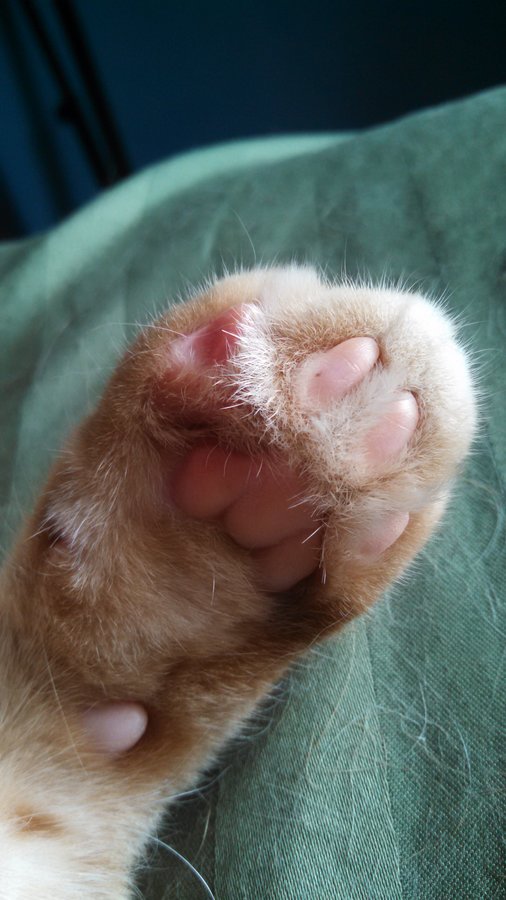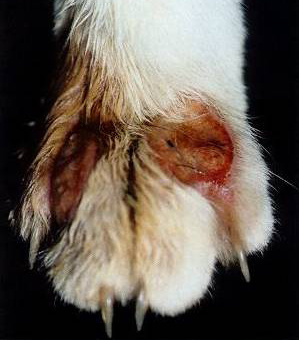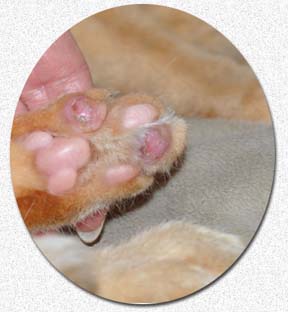eosinophilic granuloma cat paw
With cryosurgery lesions are frozen with liquid nitrogen and then removed. Common sites include the legs mouth footpads face especially under the chin.
Eosinophilic Granuloma Complex Bayside Mobile Vet
Known as eosinophilic granuloma complex the reaction can present around the cats mouth or throat chin or abdomen hind legs or footpads.

. They may be found anywhere on the body but are most common on the head face bridge of the nose ears paw pads lips chin mouth and thighs. Canine eosinophilic granulomas are rare occur the oral cavity or rarely the skin and primarily affect Siberian huskies and sporadically Cavalier King Charles spaniels. Chemotactic stimuli that attracts neutrophils in most species attracts both eosinophils and neutrophils in cats and horses.
Paw pads may become swollen. It may also be seen on the paws cheek lip commissure chin pinna of the ear and in the oral cavity. Paw pads may become swollen.
An eosinophilic granuloma is a well-circumscribed raised lesion yellowish-pink in color usually localized to the caudal aspect of the rear limb where it may be linear and is often bilateral. Eosinophil is one of bodys defense system to battle infection such as foreign materials from outside the body. It occurs when the eosinophil type of white blood cell causes the body to response infection in a wrong way.
Your cat might experience one or all three of these lesions. Inflammatory esoinophilic granulomas generally appear on the face footpads front legs or inner thighs. Eosinophilic inflammation is a common tissue reaction in cats.
Eosinophilic granulomas These lesions are alopecic hairless well-marginated red-to-orange masses that may be linear in nature. Eosinophilic granuloma of the hindlegs has been associated with the underlying disease of flea allergy. JEFFERY The eosinophilic granuloma complex is a skin condition of cats that has been adequately described 8 but little is known of its cause.
Three lesions compose the EGC. Eosinophilic Granuloma Complex EGC is a group of skin conditions that occurs in cats but rarely in dogs. It originally was thought to only be associated with.
The exact cause of feline eosinophilic granuloma complex is unknown. Eosinophilic granuloma complex is a term used to describe three forms of skin lesions in cats including eosinophilic plaque eosinophilic granuloma and indolent ulcers. Eosinophilic granulomas are raised circular yellowish to pink nodules.
Symptoms of feline plasma cell pododermatitis As it is known as pillow paw the most characteristic symptom of pododermatitis in cats is a swollen paw pad. The most common is the rodent ulcer affecting the upper lip and inside of the mouth. Eosinophilic Granuloma Complex is a hard condition to explain especially since it has several forms but we will give it a try.
Other studies suggest that the. Indolent ulcers eosinophilic plaques and eosinophilic granulomas. The eosinophilic granuloma complex includes a variety of types of skin lesions in cats including ulcers plaques and granulomas.
Eosinophilic granuloma Another disease that can affect cats paws is eosinophilic granuloma also known as lick granuloma. In some cases of feline eosinophilic granuloma your veterinarian may suggest surgical or cryosurgical removal of your cats lesions. This is more likely in cases that are recurrent.
White blood cells called eosinophils go to the rescue when your cat experiences an allergic reaction. Cats can have one or a combination of these lesions which are. Eosinophilic granulomas can occur anywhere but most appear in the mouth hind legs and paw pads.
These may include renal amyloidosis plasmacytic stomatitis eosinophilic granuloma complex or immune-mediated glomerulonephritis. On the face the lesions are often nodular in appearance and cause lip and chin swelling. When the cats footpad is affected shell develop lumps on the bottom of her paw that often become ulcerated as she walks on them.
Your cat might start scratching or licking himself. Eosinophilic Granuloma Complex in Cats - Veterinary Partner - VIN Feline allergic skin disease can take some highly ulcerative forms especially involving the upper lip. The author has seen cases affecting the footpads which were associated with certain types of cat litter.
Symptoms While severe lesions are hard to miss other early signs can be subtle. Linear lesions are found most often on the thighs but have been seen on other body locations. It is named after a type of white blood cell usually involved with allergic responses the eosinophil and it is called complex because of the number of different forms it can take.
Mouth lesions may lead to loss of appetite or drooling. Consider surgical or cryosurgical treatment. These white blood cells in shining armor can overreact resulting in eosinophilic granuloma complex.
Eosinophilic or linear granuloma is the third form of EGC. A virus recovered from a cat with a skin condition called paw. Symptoms are varied and depend on the types of lesions involved.
These ulcers are found on the edge of the upper lip in cats and can develop on one or both sides but typically are near the front. Some research studies suggest that a form of allergic response hypersensitivity reaction may be involved in the majority of cases. On the thighs the granulomas are often linear.
Eosinophilic granuloma on the leg of a cat. EGC consists of eosinophilic ulcers eosinophilic plaque and eosinophilic granulomas. The chin may become quite swollen leading to a pouty appearance.
Most commonly the lesions occur on the caudal thighs face and the oral cavity. These lesions have a characteristic microscopic appearance due to the presence of eosinophils which are a form of inflammatory white blood cell often associated with allergies. These lesions occur on the back of the thighs the face and the tongue and palate.
Indolent ulcers What causes eosinophilic granuloma complex. The granulomas are frequently crusted or erodedulcerated. The eosinophilic granuloma is a lesion that can occur on the skin mucocutaneously or in the oral cavity.
Eosinophilic plaques can also occur anywhere on the body but are most commonly seen on the ventral abdomen. Cats with eosinophilic granuloma complex suffer damage to local tissues due to biochemicals released by eosinophils that are. Eosinophilic granuloma complex lesions are not extremely common in cats however can occur on the upper lip tongue roof of the mouth or palate can be treated with veterinary dental care.
It has also been seen with an apparently genetic predilection in a colony of specific pathogen-free SPF cats.

Grooming Guide Dog Grooming Styles Dog Grooming Salons Dog Grooming

Weird Paw Condition Vet Can T Diagnose Thecatsite

Plasma Cell Pododermatitis In Lacey Wa Dermatology Clinic For Animals

International Society Of Feline Medicine Free Access Friday Novel Presentation Of Eosinophilic Granuloma Complex In A Cat Feline Eosinophilic Complex Egc Is A Common Finding In Veterinary Dermatology It Includes A
Lesions On Cat S Ear And Feet Pemphigus Ask A Vet

Dermatology Clinic For Animals Eosinophilic Granuloma Complex Cats In Tacoma Wa Dermatology Clinic For Animals

Eosinophilic Granuloma Complex International Cat Care

Eosinophilic Granuloma Complex International Cat Care

Feline Plasma Cell Pododermatitis Veterinary Practice

Feline Eosinophilic Granuloma Complex Egc Causes Symptoms And Treatment Kingsdale Animal Hospital

Cat Paws Stock Photo Download Image Now Istock

Why Are My Cat S Paws Sore And Swollen Paws And Effect

What Are Those Painful Looking Red Sores On My Cat S Lips Or Body Egc Ron Hines Vetspace 2nd Chance The Animal Health Website

Causes And Treatment Of Feline Pododermatitis Vet Focus

The Idiosyncrasies Of Itchy Cats

My Puppy S Paw Has One Pink Toe R Mildlyinteresting

What Is Rodent Ulcer In Cats And How Do You Treat It Catster

